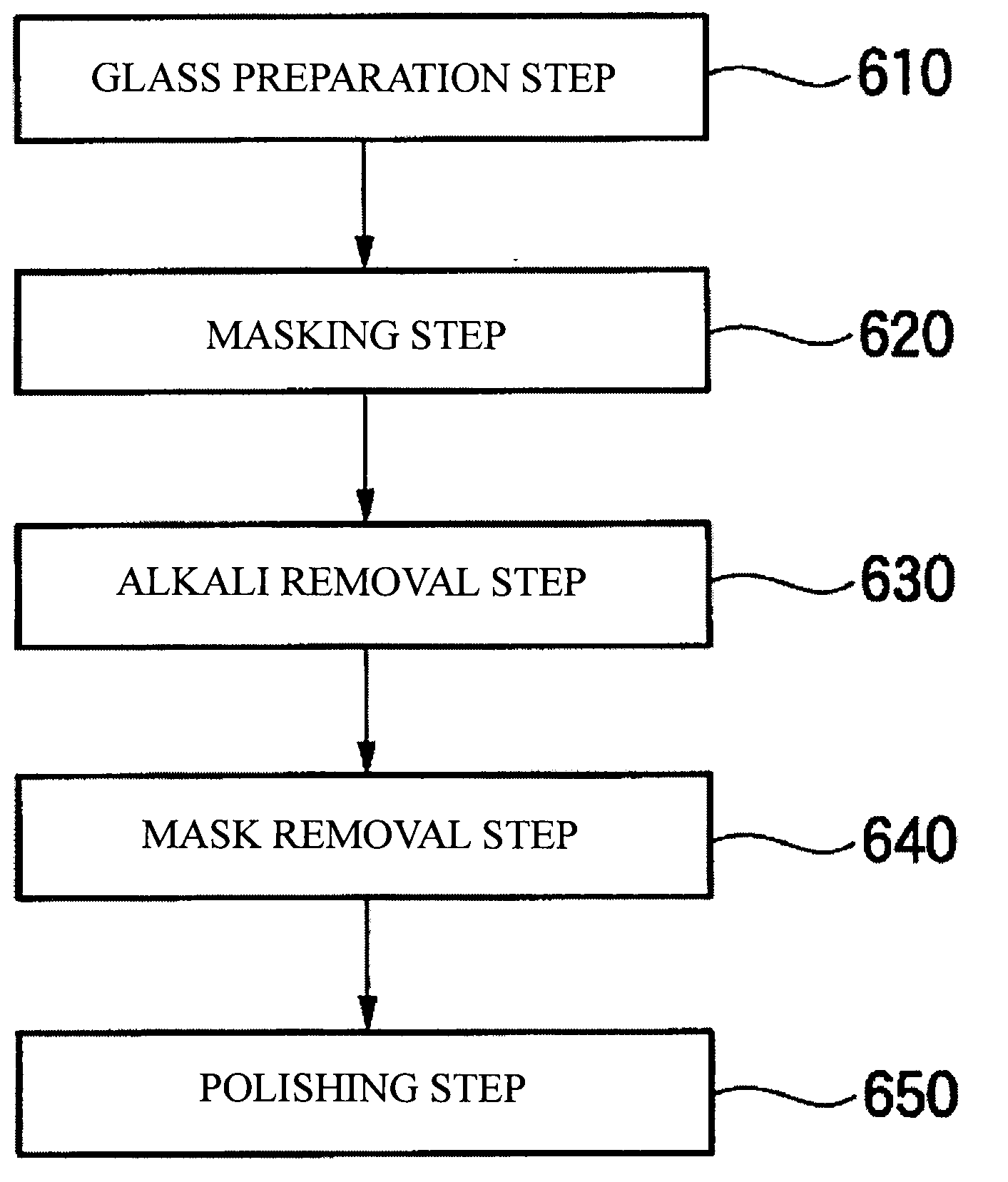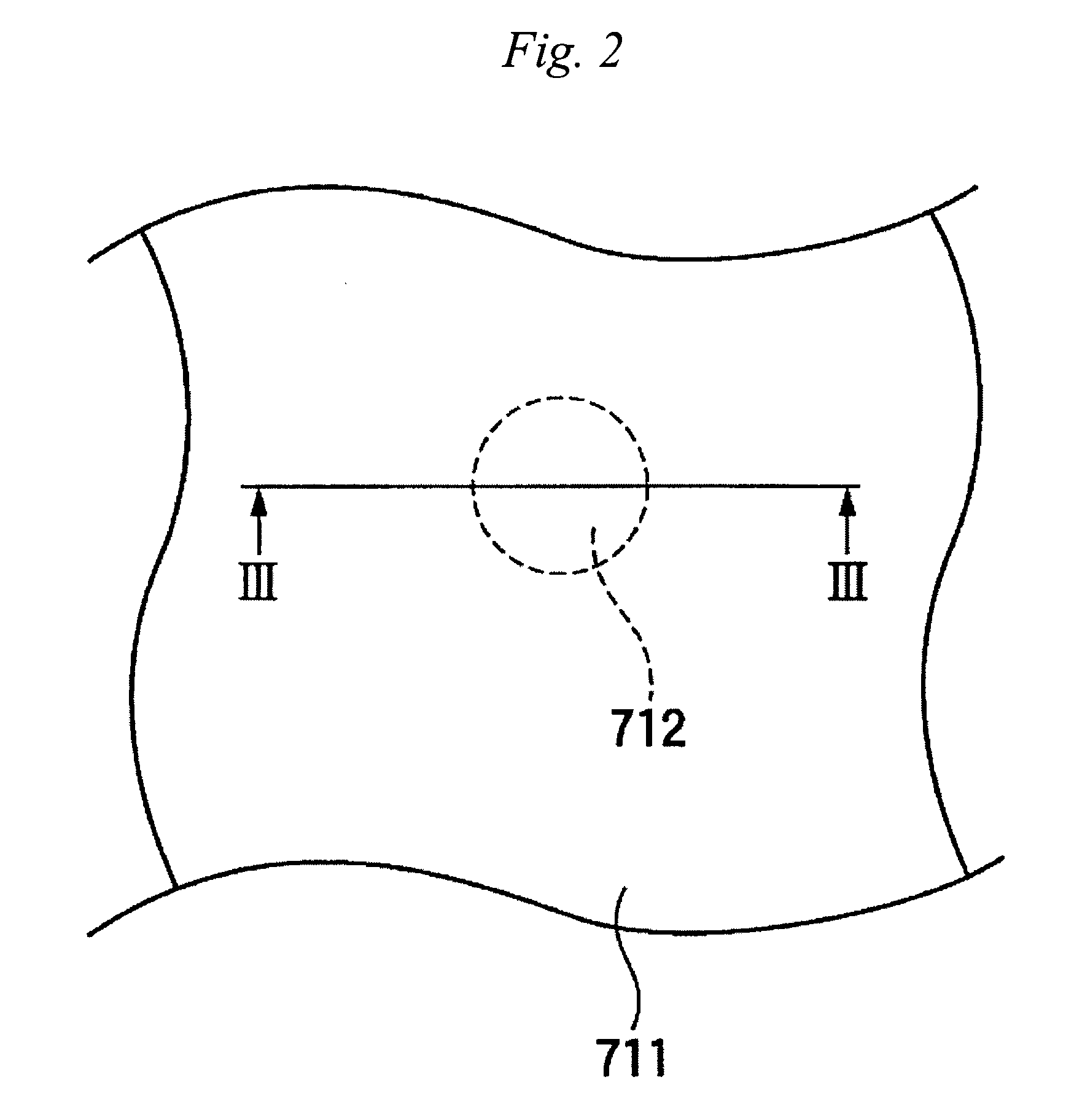Method of glass surface fine processing
- Summary
- Abstract
- Description
- Claims
- Application Information
AI Technical Summary
Benefits of technology
Problems solved by technology
Method used
Image
Examples
example 1
[0077]First, a glass which was aluminolithium silicate glass was prepared. This glass was polished with a ceria slurry or colloidal-silica slurry so as to result in an average surface roughness lower than 10 nm.
[0078]Subsequently, a given region was masked with a Kapton tape.
[0079]At room temperature, this glass was then immersed for 30 minutes in an aqueous nitric acid solution regulated so as to have a pH of 2. Thus, the region not covered with the mask was subjected to an alkali removal treatment. In the region not covered with the mask (the region subjected to the alkali removal treatment), alkali ions diffused away from an area near the glass surface and this surface was slightly eroded. As a result, the region which was subjected to the alkali removal treatment came to have a smaller glass thickness, in terms of the glass thickness measured from the back surface of the glass, than the region which had been masked (the region which had not undergone the alkali removal treatment...
example 2
[0082]The same glass as in Example 1 was prepared, and a region in the glass was covered with a Kapton tape in the same manner as in Example 1.
[0083]Subsequently, this glass was immersed for 30 minutes in an aqueous nitric acid solution regulated so as to have a pH of 2. This immersion was conducted at 40° C. as different from that in Example 1. Thus, the region not covered with the mask was subjected to an alkali removal treatment. As in Example 1, in the region which was subjected to the alkali removal treatment, alkali ions diffused away from an area near the glass surface and this surface was slightly eroded. As a result, the glass thickness in the region which had undergone the alkali removal treatment differed by 30 nm from the glass thickness in the region which had not undergone the alkali removal treatment.
[0084]The Kapton tape was then stripped off as in Example 1.
[0085]Subsequently, a colloidal-silica slurry was used to polish the glass as in Example 1. This polishing was...
example 3
[0086]Among alkali removal treatments, especially the leaching in which a glass was immersed in an acidic liquid was examined for relationship with glass composition, immersion time, temperature, and pH.
[0087]First, four glasses having the respective compositions shown in Table 1 were prepared. In Table 1, the compositions are shown in terms of % by mole.
TABLE 1GlassSiO2Al2O3MgOCaOSrOBaOTiO2ZrO2Li2ONa2OK2OA61.913.03.0———1.00.610.76.83.0B64.512.0—————1.812.85.53.4C66.54.73.46.24.73.6—1.7—4.84.4D66.45.012.1 ———3.7——5.07.7
[0088]Subsequently, glass A was immersed at room temperature in nitric acid with a pH of 2.0 for each of 5 minutes, 10 minutes, 20 minutes, 30 minutes, and 60 minutes. Thereafter, the depth of the concave portion formed in the glass A (hereinafter referred to as leaching depth) was measured. Furthermore, glass A was immersed for 20 minutes in each of nitric acids respectively having pH values of 3.0, 4.0, and 7.0, and then examined for leaching depth. The results of t...
PUM
| Property | Measurement | Unit |
|---|---|---|
| Acidity | aaaaa | aaaaa |
| Acidity | aaaaa | aaaaa |
Abstract
Description
Claims
Application Information
 Login to View More
Login to View More - R&D Engineer
- R&D Manager
- IP Professional
- Industry Leading Data Capabilities
- Powerful AI technology
- Patent DNA Extraction
Browse by: Latest US Patents, China's latest patents, Technical Efficacy Thesaurus, Application Domain, Technology Topic, Popular Technical Reports.
© 2024 PatSnap. All rights reserved.Legal|Privacy policy|Modern Slavery Act Transparency Statement|Sitemap|About US| Contact US: help@patsnap.com










